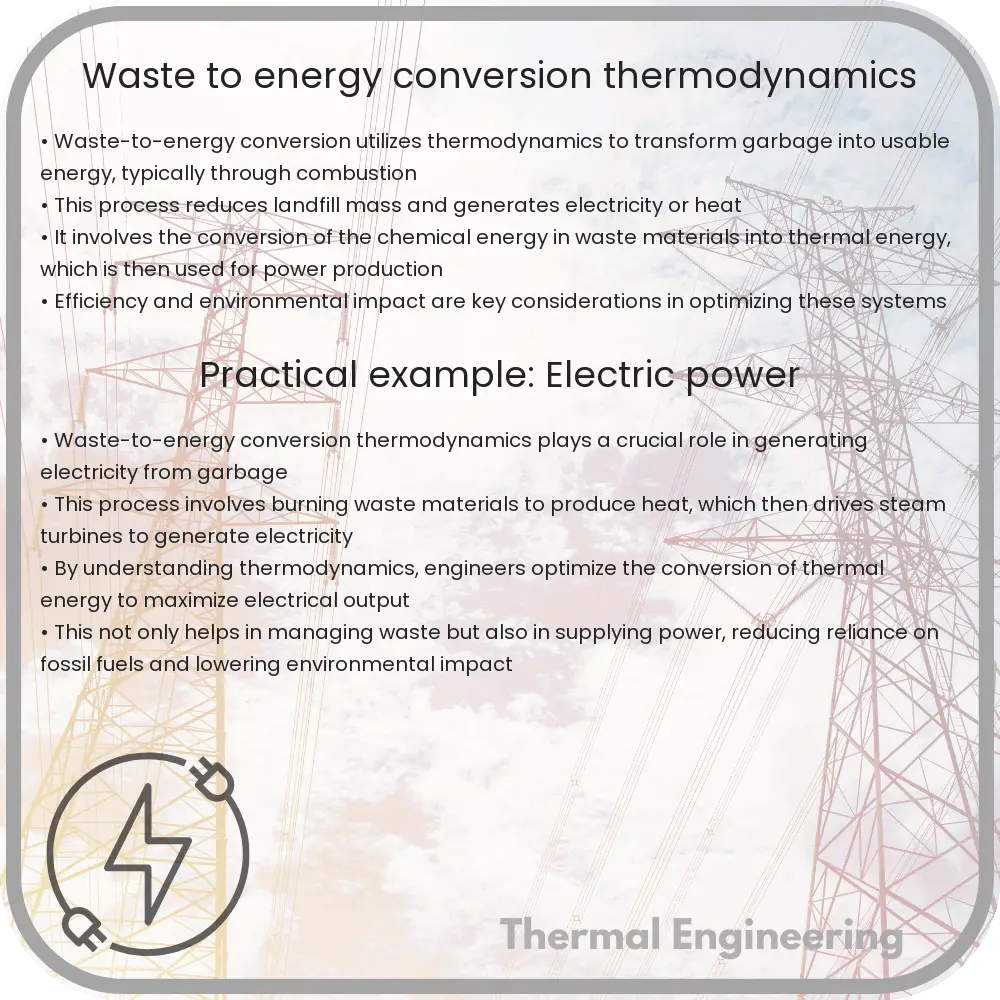Learn how thermodynamics governs waste-to-energy technology, converting municipal waste into energy while addressing efficiency and sustainability challenges.

Understanding Waste-to-Energy Conversion Thermodynamics
Waste-to-energy (WTE) technology is an innovative way to deal with municipal solid waste by converting it into usable forms of energy, typically electricity and heat. As landfills grow and the environmental impact of waste disposal becomes an increasingly pressing issue, understanding the thermodynamic principles that govern waste-to-energy processes is crucial. This article explores the basic thermodynamic concepts involved in waste-to-energy conversion and how they are applied in practical scenarios.
The Basics of Thermodynamics in Waste-to-Energy Systems
Thermodynamics is a branch of physics that deals with heat, work, temperature, and their relation to energy, radiation, and physical properties of matter. The most relevant laws of thermodynamics for waste-to-energy conversion are:
- The First Law of Thermodynamics: This law, also known as the Law of Energy Conservation, states that energy can neither be created nor destroyed; it can only be transformed from one form to another. In WTE, the chemical energy stored in waste is converted into thermal energy (heat), and then usually into mechanical energy (to turn a turbine) and finally electrical energy.
- The Second Law of Thermodynamics: This law states that the entropy of an isolated system always tends to increase over time. Entropy can be thought of as a measure of disorder or randomness. In the context of WTE, this law influences the efficiency of energy conversion systems and sheds light on why all the energy in the waste cannot be completely converted into useful work.
The efficiency of a waste-to-energy plant is fundamentally limited by these thermodynamic principles. The practical implementation of these concepts determines how effectively a WTE plant operates.
Energy Conversion Process in WTE
The typical process in a WTE facility involves several key steps:
- Waste Collection and Management: Municipal solid waste is collected and often sorted to remove recyclables and non-burnable materials.
- Combustion: The burnable waste is incinerated, releasing heat. The high temperatures convert water into steam in a boiler.
- Steam Turbine: The high-pressure steam produced in the boiler is used to drive a turbine, which generates electricity.
- Energy Conversion: The mechanical energy from the turbine is converted into electrical energy using a generator.
- Waste Treatment: The remaining ash is treated and disposed of, with metals often being recycled.
The conversion efficiency from waste to energy depends on the heating value of the waste and the technology used. Cutting-edge technologies like plasma arc gasification can potentially exceed the efficiencies of traditional incineration methods.
Calculating Efficiency
The efficiency of a WTE power plant can be estimated using the following formula:
\[ Efficiency (\%) = \left(\frac{Output\ Energy}{Input\ Energy}\right) * 100 \]
Here, Output Energy is the electrical energy produced by the generator, and Input Energy is the heat energy released by the combustion of waste. Advanced systems incorporate energy recovery techniques to utilize the heat produced during combustion for district heating, further enhancing overall efficiency.
In summary, waste-to-energy conversion is a sophisticated application of thermodynamics principles aimed at reducing waste and producing energy. While there are limitations and challenges, including emissions and the initial high cost of setting up a WTE plant, ongoing advancements in technology continue to improve the efficiency and environmental impact of this alternative energy source.
Understanding the thermodynamics of waste-to-energy processes not only provides insights into how we can manage waste more effectively but also highlights the potential for renewable energy generation from what is often considered a problematic source. As technology progresses, the role of WTE could become increasingly significant in achieving sustainable waste management and energy production goals.